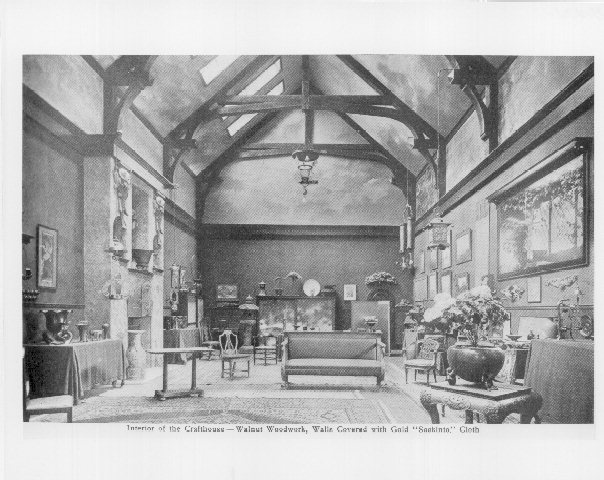
The Minneapolis Craftshouse, Bradstreet’s studio, design store, and temple to his beautiful blend of Japanese and Moorish styles with the Arts and Crafts movement.
Newspapers rarely, if ever, engage in hyperbole. They hardly ever make declarations, like where you should eat, what you should buy, or “Top 10 Things You Need to Know” about Beyonce or eggplant. So it’s surprising that the Minneapolis Journal, in 1914, declared, “If this section of the country is to furnish a name that will be known to the America of one hundred years from today, that name is more likely to be that of John Scott Bradstreet than any other.”
It is now a century later. And your first thought about John Scott Bradstreet is probably, “Who?”
The newspaper, in that 1914 obituary to Bradstreet, anticipated your ignorance. “We say ‘more likely,'” it went on, “because fame is a thing about which it is impossible to make accurate or even reasonable predictions.”
Indeed. There are statues all over Minneapolis of people whose fame had faded even before the bronze turned to green: Ole Bull in Loring Park, Gunnar Wennerberg in Minnehaha Park, Sid Hartman (who’s actually still alive) outside Target Center.

The Bradstreet Craftshouse, in its Graves 601 location. It will soon move to the former Rye deli on Lowry Hill.
But Bradstreet deserves a revival. His name, at least, has been resurrected in the form of Bradstreet Craftshouse, the Minneapolis lounge that kicked off the cocktail revival in the Twin Cities. The Craftshouse name is no coincidence: having moved to Minneapolis from Massachusetts, Bradstreet established a furniture business that evolved into a globally known interior design store and studio called the Minneapolis Craftshouse, a haven for handicraft with a heavy Japanese influence. His style, unabashedly and beautifully eclectic, was dubbed the “fellowship of good design”— essentially anything goes. Or rather, anything good goes, as American designers, he posited, were beholden to no single aesthetic or school and heir to all of them.

A Japanese-inspired design, complete with temple and torii gate, proposed for Lake of the Isles by Bradstreet and rejected by parks poobah Theodore Wirth.
In the wrong hands, this could mean a mess, but he was good at it because he had good taste. Indeed, his taste soon became the taste of the nouveau riche—in the Twin Cities and well beyond—who often had no taste of their own but could afford to buy it. Asked why Bradstreet stuck around Minneapolis when his reputation could have taken him elsewhere, a friend remarked, “The place for a missionary is among the savages.”
With the recent sale of the Graves 601 hotel, the home of the Bradstreet Craftshouse in downtown Minneapolis, the lounge will soon move to the Lowry Hill neighborhood—closer to Lake of the Isles, which Bradstreet had once proposed turning into a pseudo-Japanese temple garden. And closer to the MIA, where he’s never been forgotten.

The recently restored portrait of Bradstreet—one of the first objects to enter the MIA collection—now hanging near the Prindle House period room.
Recently, a portrait of Bradstreet was restored (by a generous contribution from Paula Vesely through the Adopt-a-Painting program) and hung in a second-floor corridor beside the Prindle House period room, a living room designed by Bradstreet. The painting was among the first few objects to enter the museum’s collection (its accession number is 06.2, as in 1906, the second object acquired that year) and shows Bradstreet in his downtown digs, which he’d remodeled into an exotic wood-paneled Moorish hookah den.

The Prindle House period room at the MIA, filled with fixtures and furniture designed by Bradstreet.
Hanging near the painting is a large bronze plaque, acknowledging the museum’s particular debt to Bradstreet. As the principal tastemaker of the town in the late 19th century, Bradstreet was among the small cadre of men who in 1883 created the Minneapolis Society of Fine Arts, which built the Minneapolis Institute of Art in 1915. In fact, the organization likely wouldn’t exist if not for his “quiet and persistent agitation through many years,” according to William Folwell, the Society’s first president. Folwell said this at the dedication of the plaque in 1916, calling Bradstreet “a minister of the beautiful, an apostle of good taste in a city and world where ugliness still abounded.”
Folwell, never one to mince words when coarseness would do, went into detail about that ugliness, noting “the absurd and vulgar holiday dress of men and women—most of all, the evening attire sported by the capitalistic cliques and their parasites.” But the point, as far as the MIA was concerned, was this: “It may not be an extravagance to say, that this institute may be regarded as a monument to Bradstreet.”

